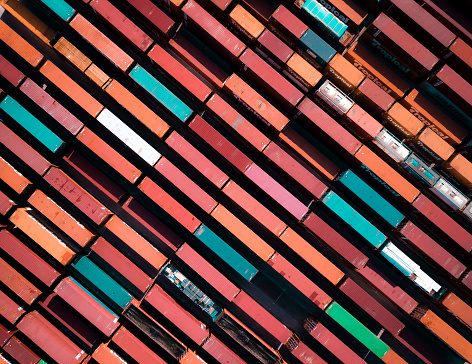In the latest of our comprehensive guides, Lynn Ng, recently appointed Chair of the ICC Banking Commission and Global Head of Commodities, Food and Agri, ING Bank, guides us through the core aspects of commodity trade finance.
This guide covers;
- What commodities are, their common features and the risks in financing them
- An overview of the different structures used in commodity trade finance, including the pros and cons of each
- A current and future market outlook – what impact has COVID-19 had on the commodity trade finance industry?
If you would prefer to download and print this guide as a PDF, you can do so here.
What are commodities?
Commodities can be defined as being typically mass-produced goods which are sold and delivered in bulk (exceptions may be precious or rare metals). They include raw materials, agricultural products, and are usually classified into 3 main categories:
- Agricultural (”Agri”) commodities are crops and animals produced or raised on farms or plantations. Most agricultural commodities such as grains, livestock, and dairy provide a source of food for people and animals across the globe. Non-food agri commodities include cotton, tobacco.
- Metals and minerals commodities encompasses (i) mineral resources like ores, alumina, extracted from mines, (ii) industrial and base metals like steel, copper, aluminium, zinc, nickel (iii) precious metals like gold, silver.
- Energy commodities include crude oil, heating oil, natural gas, and gasoline.
Commodities all typically have the following features:
- They are natural resources/ raw materials needed in every economy
- The product is fairly uniform
- Supplies are usually limited by geographical locations
- Price volatility can be significant
- They are produced, shipped/delivered in bulk quantities for economies of scale
Why is financing commodities perceived to be risky?
There are a number of risks inherent in commodities that can make financing them risky. E.g.
- High primary production risks
- Significant investments are required for energy and mining assets
- Agri commodity production is often subject to weather risks and diseases
- Commodity finance involves significant exposure due to the bulk quantities involved (production, trade volumes)
- Price volatility
- Commodity finance creates P&L volatility for the processors as they are exposed to price volatility on their raw materials and may not be in the position to adjust the sale price of their products as quickly.
- There is less impact, though, on commodity traders, unless they have taken a position. The difficulty is that the net trading position is not always known to the financier.
- Non-financial risk is deemed to be high
- Production/trade involves difficult locations that are perceived to be more risky from a (i) environmental, social and corporate governance (ESG) perspective (e.g. artisanal mining, child labour, forest clearing, social oppression), (ii) FEC/AML perspective – e.g. bribery, corruption, money laundering, fraud
- Complex – as it involves multiple parties in the transaction, and typically involves cross-border jurisdictions.
Introducing commodity trade finance
The place and time of production of commodities is usually different from the place and time of consumption. Hence, physical trade will always need to take place, either to bring it from location to location, and/or to bridge the timing gaps.
Commodity trade finance is the financing of the physical trade (purchase and sale) in commodities.
You may hear other financing terms used when discussing commodities. Below we have outlined how these terms differ:
Commodity finance is the generic term for financing everything in the commodity value chain, from production to processing to trade.
Commodity trade finance (what we are focusing on in this post) is a sub-set of commodity finance, referring more to the financing of the underlying exchange of the commodities from supplier to buyer, and is tied to the underlying asset conversion cycle.
Structured trade finance is another sub-set of commodity finance, where specific financing techniques are adopted to minimize the financing risks, mostly in situations where the tenor exceeds the typical asset conversion cycle.
The main players involved in commodity trade finance are:
- Producers – producers typically require longer tenor financing in order to finance the purchase/development of their fixed assets. Repayment is dependent on the cashflow from operations.
- Traders/trading houses – traders typically require short-term financing (tenor is usually between 30-180 days), tied to the asset conversion cycle of their trades – bridging their purchases till the sale of the commodity.
- Primary processors – primary processors typically require a mix of longer-term financing as well as short term working capital financing.
How does commodity trade finance work?
Commodity trade finance may be defined as providing the financing to bridge the purchase of the commodity, e.g. by a trader, till the sale of the underlying commodity by the trader to e.g. a processor. It should be noted that this does not necessarily involve actual funding, but can be structured in the form of a contingent instrument, the most common of which are letters of credit.
The strength of the borrower’s governance, financial position and the type of commodities flow handled determines the structures applied. In general, the weaker the position, the tighter the controls applied.
The structures may generally be classified as being one of the following:-
- Transactional trade finance
- Borrowing bases
- Working capital
- Structured trade finance
We’ll cover each one in turn and examine some of their pros and cons.
Transactional trade finance
Physical flow of goods
This is where a trader enters into a purchase agreement with the supplier for the commodity (say 5,000mt of wheat) and simultaneously sells the same to the buyer.

Documentary/payment flows
Against this contract, the trader goes to its bank to request it to finance the purchase (import – if cross border trade is involved), on the understanding that the sales proceeds (export – if cross-border trade is involved) will be utilized to repay the financing of the purchase.
In order to facilitate the import financing, the trader’s bank will require documentary evidence (e.g. invoice, shipping/transport documents, certificates of quality/quantity, etc) from the supplier before payment is made on behalf of the trader, and will require that such documents be verified/authenticated through the supplier’s bank.
Such documentary evidence, is then submitted to the buyer’s bank, which will then pay the proceeds to the trader’s bank.
Here’s an example of a typical transactional trade flow:

- Trader informs the bank of transaction details with the bupplier and the buyer.
- The supplier delivers the goods, but retains title (via documentary evidence, e.g. bills of lading), the trader in turn commits to deliver the sale to the buyer.
- The supplier delivers the documents to the supplier’s bank
- The supplier’s bank forwards the documents to the trader’s bank (either under documentary collection or under the import letter of credit (‘’LC’’) issued by the trader’s bank)
- The trader’s bank checks that the documents received are in order (if under LC) and makes payment on behalf of the trader (either debiting the trader’s account or creating a loan).
- The supplier’s bank informs the supplier that payment is made.
- The trader’s bank submits the documents to the buyer’s bank (either under documentary collection, or under the export letter of credit received from the buyer’s bank)
- The buyer’s bank checks that the documents received are in order, informs the buyer and makes payment to the trader’s bank on the buyer’s behalf.
- Documents are released to the buyer, who then takes physical delivery of the goods using the documents received.
- The trader’s bank informs the trader that of the receipt of the sales proceeds, and in the case of where a loan was created, the proceeds are utilized to repay the loan, with the difference credited to the trader.
There are variations to transactional trade finance, e.g. pure inventory finance, or even the discounting of a specific receivable. The key characteristic for all variations, is that the exposure is self-liquidating, i.e. that the source of repayment is identified, and the financier is able to look to the underlying goods/receivables to extinguish the outstanding exposure.
Pros and cons of financing on a transactional basis
Transactional trade finance is transparent, self-liquidating, and thus easier for banks to assess the risks and finance, as the risks can be mitigated with a clear, independent source of repayment. However, it is labour intensive to administer and control. Hence, it is uneconomical for trades involving small value shipments.
The benefit of such a structure is that financiers will be more prepared to increase the financing in times of rising commodity prices. This enables the commodity trader to commit very quickly on their transactions, even in times of fast rising commodity prices.
Borrowing bases
Borrowing base structures allow banks to finance against an aggregated pool of working capital assets (typically inventory, receivables) that are given as collateral. The assets are valued on a periodic basis (weekly, fortnightly, monthly) at an agreed percentage/advance margin that takes into consideration the liquidity and the quality of the underlying assets. This value then serves as the maximum limit for drawings under the facility.
Pros and cons of financing on a borrowing base basis
Such facilities are less laborious relative to transactional trade finance, but require that the financier be comfortable with the reporting capabilities of the borrower. Typically, there will be covenants which enable the financier to conduct independent checks on the assets reported.
For example the requirement for an independent audit to be performed at the option of the bank, or to perform verifications with the warehouse (in the case of inventory), or the buyers (in the case of receivables). The more frequent, and the more intense the checks, the greater the reliability of the base, but this increases the labour intensity and costs for the bank.
As the borrowing bases are reported on a historical basis, the commodity trader might find it difficult to operate in times of fast rising commodity prices, as there will be a lag in the reporting
Working capital

These are facilities extended purely based on the perceived credit strength of the borrower, which is based on the assessment of the borrower’s business and financial strengths based on past track record.
Pros and cons of financing on a working capital basis
This is the least invasive structure (for the borrower) and the least labour intensive for the financier, but offers the least level of control and hence comfort to the financier.
It requires a high level of trust in the borrower’s repayment capabilities, formed from the assessment of the historical track record, or the provision of alternative collateral that can help to mitigate the risks (e.g. corporate guarantee from a stronger parent, or provision of other collateral).
Because it is extended based primarily on historical performance (annual audited financial statements), it does not take into consideration the current market environment and circumstances. This can be challenging for the commodity trader in times of high commodity prices, as the working capital facilities may not grow quickly enough since the banks have less insight into their current performance and positions.
Structured trade finance
These are techniques/structures deployed to finance specific situations where the tenor of the financing exceeds the typical asset conversion cycle. Some examples include:
Prepayments
To secure supplies on a long-term basis (or to obtain preferential terms), the trader may be required to provide prepayments to the suppliers. The prepayments are repaid from a stream of supplies in the future. The trader may approach the bank to provide the financing by assigning the future flow of supplies to the bank.
Such financing may be offered with recourse to the trader, or on a limited recourse or without recourse to the trader. The determining factor is the bank’s assessment of the performance risk on the supplier.
Tolling
The trader may supply raw materials to a processor and choose to offtake the processed material instead of an outright sale. The trader’s bank may be requested to finance the purchase of the raw material, against the assignment of the sales proceeds from the processed material.
Risk mitigation techniques vary, from a straight forward exchange of raw materials for already produced goods against a pre-agreed price, to a more complicated one that includes also taking control over the production process and work-in-progress.
Structured inventory product/repo
Here the goods are sold to the bank (or an SPV) with the agreement that the trader will buy it back within an agreed time frame for an agreed price. The price will be sufficient to cover the cost of holding the inventory for the duration plus an agreed margin.

Advanced Commodity Finance
Current and future market outlook
What impact has the COVID-19 pandemic on the commodity trade finance industry?
Apart from the initial few weeks of confusion in the logistics and documentary flows, the commodity trade flows, especially of staple foods like grains and edible oil have proven to be fairly resilient as commodities are the basic building block of the economy. There will always be a fundamental base demand. The fact that most commodity prices recovered by the 3rd quarter of 2020 bears testimony to this fact.

Of the 3 commodity classes, energy commodities took the worst beating as world travel ground to a halt, resulting in an over-correction with the WTI briefly hitting an unprecedented negative US $37 per barrel in April 2020, and quickly recovering to US $40 per barrel in the subsequent months.
Whilst it is true that there was a decrease in demand of an estimated 9% , energy is still required to power the world’s production/processing activities, fuelling the logistics to transport the commodities, and essential goods. In the longer term, we will see shifts in the energy complex as a result of energy transition.
As with most crisis, the number of players in the commodity value chain reduced, with a flight to quality as weaker players become uncompetitive. Major commodity trading houses have benefited from this.
How has the industry tried to restore its reputation following the frauds, alleged frauds and bankruptcies that took place in 2020?
Driven by the reduced liquidity and access to trade finance, there is a greater willingness by the industry to provide more information and security to the financiers. Banks are able to structure the financing facilities more appropriately to fit the purpose, e.g. ensuring that the tenor of the financing fits with the asset conversion cycle.
There is also an increased willingness to collaborate to find solutions to help authenticate the trade details and information.
What does the future look like?
We can expect trade to become more digital, with increasing acceptance of the electronic transferable records. Whilst there are many technological tools and platforms that provide electronic records, the difficulty has been that they all exist as siloes and do not facilitate the exchange of records outside of the silo.
As trade involves multiple parties, across multiple jurisdictions, it is uncommon for all parties to be on a singular platform. As such, a unifying standard to enable this exchange is necessary. Once this code is cracked, we will see an exponential growth in the use of e-docs.
Another development that must take place, is the legislature to give e-documents and instruments like electronic-bills of ladings and promissory notes, the same legal status as their paper-counterparts. In this regard, the UNCITRAL’s Model Law on Electronic Transferable Records (MLETR) was issued in 2017, but adoption rate has been slow.
Thus far, only 3 jurisdictions (Bahrain, Singapore and Abu Dhabi) have incorporated the MLETR, with the latter 2 only this year. Once the major trading hubs adopt MLETR, this will ease further ease the exchange of electronic records.





